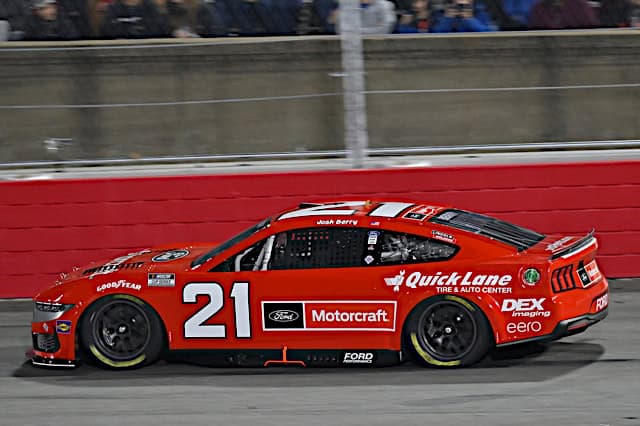As mentioned in the first installment of Frontstretch‘s series commemorating the 75th anniversary of Wood Brothers, NASCAR’s oldest team can trace back to its roots … literally.
The Wood Brothers’ patriarchs, Glen and Leonard Wood, built their first race car under a beech tree in 1950, running their first race at Morris Speedway near their home of Stuart, Va.
While that beech tree is no longer on property owned by a Wood family member, it still stands as a symbol for the family and their history.
“The tree is still alive,” WBR co-owner and president Jon Wood told Frontstretch. “When [Glen’s] brother (Ray Lee Wood), who owned the property when he died, that property was sold. There’s a new lady that owns the property that the tree is on, and she lets us do whatever. If we want to go and have a family picture there, she’s cool with it. It has more of a symbolic meaning and something to talk about instead of something to go and have a ritual around.”
It is extraordinary to watch how a tree grows, turning from a tiny seed into a colossal canopy.
As it grows, trees face threatening weather conditions through a process called thigmomorphogenesis.
The plants will release hormones in response to things like touch, wind, or rain. These hormones will alter the character of the plant’s support system, enabling it to both withstand storms while also helping it survive future, natural threats. While many trees are blown over each year, the toughest are ones that have withstood storm after storm.
Over 75 years, the Wood Brothers family has transcended the elements that have uprooted several other teams and drivers. It has branched out across decades of success, while staying upright through its most trivial periods.
Many icons of motorsports have watched first-hand how the team’s values and drive have aided it through the years, and generations have grown up alongside them. That includes Clay Campbell, president of Martinsville Speedway and the grandson of the track’s owner, H. Clay Earles.
Like so many others, Campbell’s family has developed a strong bond with the Wood Brothers. And as someone who’s grown up witnessing the team’s accolades, Campbell has seen how much the team has impacted NASCAR.
“It would be a totally different NASCAR without [Glen and Leonard],” Campbell told Frontstretch. “You needed pioneers back in the ’40s to get things started, but from a track standpoint and competition standpoint, you’ve got both buckets covered by the two of them. If you look back in history at all the drivers that have driven for the Wood Brothers, it’s a ton of them, and it’s who’s who list of great drivers.”
Campbell’s inspiration to get involved in the sport certainly came from his grandfather, but aspects of the Wood Brothers grew that passion, such as his childhood favorite driver, David Pearson, who won 43 races with WBR.
“For me, when Pearson was driving for the Woods, I was a teenager,” Campbell recalled. “That was back when you had Pearson, [Richard] Petty, [Cale] Yarborough. Drivers like that, for a young kid like myself, they were real-life heroes, but Pearson was always a hero. You just think of David Pearson and that Purolator (No.) 21, enough said. And I think that probably sent the Wood Brothers on a further trajectory towards being the marquee team that they were and still are for that matter.”
The friendship between the Wood and Campbell families has benefited both sides on and off the track, mirroring the connections of other partners who helped each other. When the team was focused on excelling at larger tracks, Earles made sure Martinsville had a spot for the home-track team, which was based 30 minutes away from The Paperclip.
“My grandfather was adamant that the Wood Brothers, being 30 miles up the road, had to be [at Martinsville],” said Campbell. “It was a deal between my grandfather, Glen Wood and Leonard to make sure that they ran this race, and they always did. So it was special to have that (No.) 21 running at Martinsville when it wasn’t running other tracks of like size.”
Even though the organization only has two wins at Martinsville, the track where it has started more than any other, the sole presence of the team signified its important during the building stages of NASCAR. And as the years have transpired, Campbell has seen the imprint the family has forever forged on the sport.
“If you look back at the beginning, they started up that ladder of success, and it started with Glen driving race cars,” Campbell said. “But there are very few names in this sport that resonate with the fans. Whether you be a fan, or a casual fan, or don’t know much about NASCAR at all, you’ve probably heard the name, Wood Brothers. It’s synonymous with NASCAR. Other than the Pettys and the Woods, it’s not many that have that wow factor that most people have heard of.”
As Campbell put it, having a name is one thing, but bringing success along with it is what fueled the team over seven decades. Relationships like those with the Ford Motor Company have been instrumental to the team’s road map, which included an Indianapolis 500 crown in 1965 with Jim Clark. Having the right people in place also set the team apart, with a gem of an engineer in their corner.
“Leonard is probably one of the sharpest guys I’ve ever met as far as ingenuity, and still is,” Campbell said. “He could take a wheelbarrow and make the best wheelbarrow out of it. I think people like that and that entire team, you’ve got the family running things — Jon, Eddie — it’s a great organization.”
For Jon Wood, racing is all he’s ever known. The third-generation co-owner has watched the ebb and flow of both the sport and team as an observer at the race shop, a driver, and now, one of the people in charge.
To Wood, the changes in NASCAR have been more monumental and substantial than other motorsports disciplines, making the demand to adapt more prevalent. The sport also hinges on the support and investment of sponsors more than ever before.
As the son of a successful Little Debbie employee, I’ve seen firsthand how WBR has been involved in marketing itself, from product displays to merchandise promoting both the No. 21 and America’s favorite snack cake from 2006-2008. Yet, as important as those metrics have become, it’s not what has rooted the team in its history.
“I think the reason we’re still around is more based in the relationships that have been formed, and not so much how we deliver a product, sell products in a grocery store, or whatever way sponsorship metrics are measured,” Wood said. “Ours is based on relationships, and that’s how we’ve managed to weather the crisis that we’ve faced.”
Wood can speak to the lowest point of the team’s history, not as the owner, but as a driver. Seeking to emerge onto the NASCAR Cup Series scene, the two-time NASCAR Craftsman Truck Series winner made four starts in his family’s ride between 2007 and 2008. However, that came in a stint between 2007 through 2010 where the team recorded exactly one top 10, ending Wood’s career before it really started.
“I think back to the late 2000s, and our cars were not good,” Jon Wood said. “It was a really trying time, and we were fortunate that Ford gave us the backing that they did to allow us to scale back to part-time to regroup and find a strategy that would work.”
The latest chapters in WBR’s history have finally seen more fruit hang from the branches after years of pruning. It started with the formation of a technical alliance with Team Penske in 2015 and bringing on rising star Ryan Blaney to pilot its ride.
“We found [a strategy] when we partnered up with Team Penske, it just made it a better fit,” Wood said. “It was perfect timing that Ryan Blaney was coming onto the scene, and he needed development, and Team Penske didn’t have a place for him. We needed a driver, we needed a way to fill out our schedule, and that’s how we kind of got jump-started.”
Perfect timing has defined a lot of the team’s ability to adapt and move forward over 75 years. Pearson joining in 1972 was timely. Motorcraft joining in 2001 when Citgo pulled its sponsorship was timely. Paul Menard bringing Menards over in 2019 when Blaney departed for Penske was timely. Timeliness reigned once again when Stewart-Haas Racing disbanded, allowing the team to sign Josh Berry.
That same pattern is special to Wood relating to his favorite memories over the years. He wasn’t in victory lane as a teenager when Elliott Sadler won at Bristol Motor Speedway in 2001, nor at Trevor Bayne‘s dream-come-true win in the 2011 Daytona 500.
Even though he was there for Blaney’s 2017 triumph at Pocono Raceway, he didn’t feel entwined in the ownership at the time.
Wood finally got to celebrate as the team’s co-owner last August at Daytona International Speedway, where the echoes of NBC Sports broadcaster Leigh Diffey’s call “Jeff, your little boy has done it” still ring following Harrison Burton‘s victory to seal win number 100 for the team. Not only did Wood celebrate the milestone win, but he also got to be there with his 7-year-old son, bringing another generation of Wood to victory lane.
So, what’s the vision for a team who has faced changing tides head-on since 1950?
For Wood, there’s no complex formula, but rather, simple: stay relevant.
“It wasn’t as apparent at the time when Harrison won, but it’s apparent when I look back now at how much we needed that to just be talked about again,” Wood affirmed. “As long as we’re doing things where we’re being talked about, and we’re not doing things that we’re talked about in a bad way, that’s all I can really hope for. The competitiveness will take care of itself.”
Going back to the beech tree, look at how much the Wood Brothers’ tree has grown. 101 wins (102 if you count Michael Waltrip‘s 1996 All-Star win). Nearly 50 drivers, 20 of whom have won in the No. 21 (and Kyle Petty in the No. 7). Twenty drivers on NASCAR’s 75 Greatest Drivers list. Wins in eight different decades. And just a couple of brothers who established one of the greatest operations in motorsports history.
Safe to say, this tree is a giant compared to the ones around it.
How do you summarize 75 years of racing, memories, and relationships? Let the results and stories speak for themselves.
Here’s to 75 more, Wood Brothers Racing.
Entering his fifth year with Frontstretch, Luken Glover is the author of The Underdog House, shedding light on the motivation and performance of NASCAR's dark horse teams as they strive to fight to the top. Additionally, Glover reports for the site at various events, and he contributes in the video editing department.
A 2023 graduate of the University of the Cumberlands, Glover is a middle school math and PE teacher, as well as a basketball coach. He is passionate about serving in his church, playing/coaching a wide variety of sports, and researching motorsports history.






